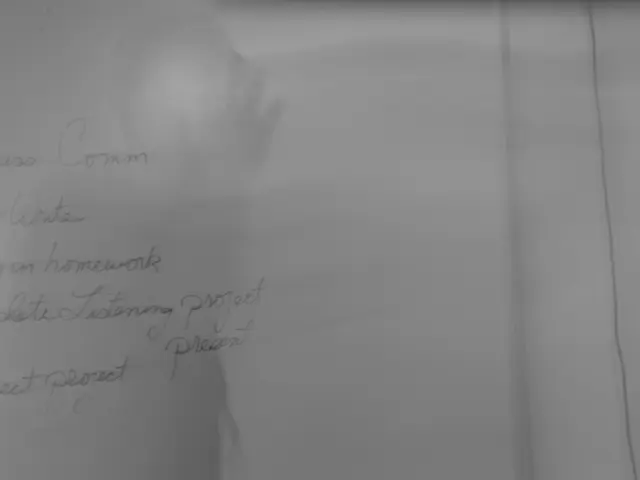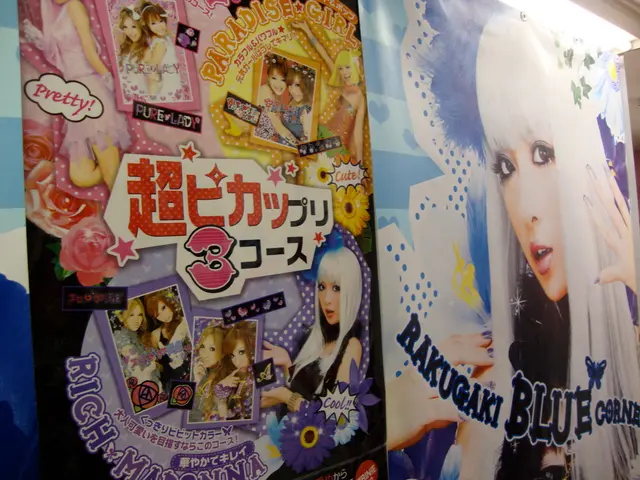Escaping the Work Frustration Vortex: Shattering Chronic Dissatisfaction
Strategies to Break the Negative Cycle
Share on Facebook Tweet this Whatsapp this Email this Print this Copy Link Are you consistently irked at work? If dissatisfaction persists, productivity and well-being plummet. Here's how to recognize and break free from this negative cluster.
Ever felt like the third CC'd email of the day, irrelevant to your role, leaves you seething? Or, how about that talkative coworker who always disrupts your focus at crucial moments? You think you're overreacting, but these seemingly small issues are taking a toll on your mental health?
If your work environment stirs up more frustration than inspiration, it's time to take action. But how do you free yourself when negativity dominates your professional life?
How does a vicious cycle of work frustration formulate?
This cycle of work frustration usually develops through a dynamic mix of internal and external factors. It often starts subtly then intensifies if not addressed promptly. "One negative thought feeds another," explains career coach Ragnhild Struss. The more irritations you encounter, the more entrenched you become in your negative mindset.
Expert Insights Stress for the Body and Soul? Experts Worry About Weekend and Shift Work External circumstances alone—poor work atmosphere, overload, or lack of recognition—are rarely the sole causes, Struss explains. "Internal factors create fertile ground for external issues to breed dissatisfaction," she adds. Internal factors encompass:
- Self-doubt
- Perfectionism
- Scarce self-efficacy
- or a pessimistic worldview coupled with negative beliefs such as "I can only be good enough if I'm perfect."
How do you recognize when you're trapped and not simply going through a rough patch?
It's often challenging to spot the gradual worsening. "We don't realize how it's getting worse bit by bit," acknowledges Laura Venz, professor of work and organizational psychology at Leuphana University Lüneburg. However, it's helpful to analyze your behavior and consider your thoughts and emotions regularly. Using a diary or journal to record your reflections can be helpful. Additionally, feedback from colleagues, superiors, friends, or family members should be taken seriously.
Expert Insights "Ghostworkers" Beware: When is a break during work fraud? The longer a person falls into this cycle, the more resistant they become to change. Those who are highly perfectionistic or workaholic may take longer to realize it. In contrast, individuals who are more mindful of themselves and reflective will recognize it sooner and can act faster.
What warning signs should you watch for?
Typical indicators include:
- Persistent frustration
- Anger and irritability
- Enhanced susceptibility to conflicts and disagreements
- This can also include:
- A feeling of helplessness or hopelessness
- Emotional exhaustion or burnout symptoms
- Diminished motivation and withdrawal
- Focus difficulties
- Memory problems
- Decision-making struggles
- Physically, signs may appear such as:
- Chronic fatigue
- Sleep disturbances
- Headaches
- Muscle tension
What short-term solutions can help?
In critical moments of frustration or overload, Ragnhild Struss recommends taking a deep breath, pressing pause, and stepping back from the situation internally. This breaks the cycle and offers distance from the stressful scenario.
Tactics like mindfulness practices—meditation, breathing exercises, or brief body scans—offer clarity about the current situation and help prevent impulsive reactions, promoting conscious action, such as stepping back from stressful situations or taking a short outdoor walk.
What helps in the long run?
Crucially, recognizing when trapped in a negative spiral is essential. Laura Venz suggests first evaluating the situation. Can the workload be reduced, for example? "Then, it's about how the person can better manage the load."
Note: Venz stresses that if the workload is too high, it's the responsibility of the organization to change rather than the individual. "If the manager is the problem, one must find another job," she emphasizes.
When is professional help required—and what options are there?
Initially, it's possible to find solutions independently. Speak to colleagues, your partner, or friends. However, if one is so deeply ensnared that they can't escape or if it takes on unhealthy dimensions, external assistance is necessary.
To permanently shift patterns and beliefs, professional reflection through coaching or psychological accompaniment can be decisive. This helps establish new, beneficial patterns.
Larger companies usually have internal health management programs, while health insurance providers and scientifically based apps can offer support. The Federal Institute for Occupational Safety and Health (BAuA) also provides access to various educational resources.
How can one prevent it from recurring?
It's crucial to intentionally establish conditions that foster sustained satisfaction and inner stability over the long term. "A negative spiral is a psychological wake-up call signaling that the lived life doesn't align with your personality," states Struss. Prevention lies in proactive, authentic living rather than reactive responses.
In conclusion, acknowledging and addressing both overt and covert workplace frustrations is essential for thriving professionally. By taking control, adopting healthy habits, and refusing to accept negativity, one can transcend the frustrating cycle and forge a path to lasting career contentment.
References
[1] Mindful.org. (2020). Mindfulness at Work. https://www.mindful.org/mindfulness-at-work/[2] HBR.org. (2018). How Burnout Can Save Good Leaders. https://hbr.org/2018/12/how-burnout-can-save-good-leaders[3] Harvard Business Review. (2016, March 29). How to Break Up with Your Job. https://hbr.org/2016/03/how-to-break-up-with-your-job[4] Deloitte.com. (2020). The Role of the Workplace in Employee Health and Well-being. https://www2.deloitte.com/us/en/insights/focus/health-care-consumer/the-role-of-workplace-in-employee-health-and-well-being.html[5] Accenture.com. (2020). Goodbye burnout, hello wellbeing. https://www.accenture.com/us-en/insights/future-now/wellbeing# Keywords* Stress* Employer* Employee* Psychology* Occupation* Workplace Frustration
Enrichment Data:Overall:A vicious cycle of chronic frustration at work usually arises from recurring stress, misaligned expectations, poor communication, and unhealthy workplace norms. Here's how this pattern typically forms and escalates:
- On-going Stress and Unfulfilling Work: Continual pressure, unclear objectives, and lack of meaningful engagement result in chronic emotional, mental, and sometimes physical exhaustion, often termed burnout.
- Excessive Workloads and Deadlines: Tight deadlines and excessive demands contribute to working lengthy hours, blurring boundaries between work and personal life, and increasing stress and dissatisfaction.
- Poor Communication and Leadership: Leaders who fail to share vision or foster open dialogue create confusion, undermine trust, and hinder workplace safety. Employees start to disengage and stop sharing concerns.
- 24/7 Work Culture: The expectation to be accessible around the clock and the constant influx of messages (emails, chats, meetings) results in information overload and decision fatigue, further exhausting employees and hindering effective prioritization and action.
- Lack of Recognition and Accountability: Employees who feel overlooked or observe bad behavior going unpunished become resentful and cynical, increasing frustration and disengagement.
- Misaligned Values and Poor Conflict Resolution: When company actions don't correspond with stated values or conflicts are ignored, trust erodes, and frustration becomes normalized.
Strategies to Break Free:
- Promote Meaningful Work and Learning: Encourage employees to find purpose in their roles and provide opportunities for growth and skill development, countering feelings of stagnation and dissatisfaction.
- Clarify Roles, Goals, and Expectations: Clearly communicate vision, objectives, and responsibilities, reducing confusion and empowering employees with a sense of direction.
- Improve Communication Channels: Foster two-way communication, encourage feedback, and ensure information flows both vertically and horizontally within the organization to prevent silence and frustration.
- Establish Healthy Boundaries: Establish and respect work-life boundaries, limit after-hours communication, and encourage regular breaks to prevent burnout.
- Recognize and Reward Employees: Regularly acknowledge contributions and swiftly address toxic behaviors to build morale and trust.
- Prioritize Psychological Safety: Create an environment where employees feel safe to express concerns without fear of retaliation, and handle conflicts constructively.
- Review and Adjust Workloads: Ensure deadlines and expectations are realistic, and provide support for employees handling excessive demands.
By tackling both systemic and interpersonal issues, organizations can dismantle the cycle of chronic frustration and foster a healthier, more engaged workforce.
- Incorporating vocational training programs into the community policy could help individuals develop relevant skills for career-development and education-and-self-development, potentially mitigating feelings of dissatisfaction and frustration in the workplace.
- Decisions regarding workplace-wellness and health-and-wellness initiatives should consider mental-health aspects, as job-related stress impacting mental health can lead to chronic frustration and reduced productivity, according to the text.
- Recognizing the importance of consistent feedback and open communication within the workplace is crucial for promoting workplace-wellness and a positive mental-health environment, as chronically frustrated employees may feel disengaged due to poor communication and unclear expectations.








